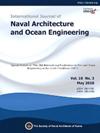大倾斜螺旋桨叶片缺陷验收标准及质量控制措施的制定
IF 3.9
3区 工程技术
Q2 ENGINEERING, MARINE
International Journal of Naval Architecture and Ocean Engineering
Pub Date : 2025-01-01
DOI:10.1016/j.ijnaoe.2025.100685
引用次数: 0
摘要
大倾角螺旋桨(HSPs)是一种倾角大于25度的螺旋桨,被广泛用于提高推进效率和降低噪声。然而,其独特的几何形状会对疲劳性能产生负面影响,特别是在容易产生铸造缺陷的镍铝青铜(NAB)叶片中。本研究重新评估了当前的质量控制标准,重点关注焊后热处理(PWHT)的热脆风险,这可能会降低修复焊缝的抗疲劳性。为了在满足质量标准的前提下提高疲劳寿命,提出并优化了喷丸强化方法。此外,开发了一种新的缺陷评估算法,将应力强度因子范围可视化(ΔK),并基于疲劳裂纹扩展阈值识别严重区域(ΔKth)。在严重区域内的缺陷进行疲劳裂纹扩展分析,而在严重区域外的缺陷可能不需要修复。该方法能够更有效、定量地评估缺陷可接受性,从而提高热热加热刀片的可靠性和质量控制。本文章由计算机程序翻译,如有差异,请以英文原文为准。
Development of flaw acceptance criteria and quality control measures for highly skewed propeller blades
Highly skewed propellers (HSPs), with skew angles over 25 degrees, are widely used to improve propulsion efficiency and reduce noise. However, their unique geometry can negatively impact fatigue performance, especially in nickel-aluminum-bronze (NAB) blades prone to casting flaws. This study re-evaluated current quality control standards, focusing on the risk of thermal embrittlement from post-weld heat treatment (PWHT), which may lower fatigue resistance in repair welds. As an alternative, shot peening was proposed and optimized to enhance fatigue life while meeting quality standards. Additionally, a new flaw evaluation algorithm was developed to visualize the stress intensity factor range (ΔK) and identify severity zones based on the fatigue crack growth threshold (ΔKth). Flaws inside the severity zone undergo fatigue crack growth analysis, while those outside may not require repair. This method enables a more efficient, quantitative assessment of flaw acceptability, improving both the reliability and quality control of HSP blades.
求助全文
通过发布文献求助,成功后即可免费获取论文全文。
去求助
来源期刊

International Journal of Naval Architecture and Ocean Engineering
ENGINEERING, MARINE-
CiteScore
4.90
自引率
4.50%
发文量
62
审稿时长
12 months
期刊介绍:
International Journal of Naval Architecture and Ocean Engineering provides a forum for engineers and scientists from a wide range of disciplines to present and discuss various phenomena in the utilization and preservation of ocean environment. Without being limited by the traditional categorization, it is encouraged to present advanced technology development and scientific research, as long as they are aimed for more and better human engagement with ocean environment. Topics include, but not limited to: marine hydrodynamics; structural mechanics; marine propulsion system; design methodology & practice; production technology; system dynamics & control; marine equipment technology; materials science; underwater acoustics; ocean remote sensing; and information technology related to ship and marine systems; ocean energy systems; marine environmental engineering; maritime safety engineering; polar & arctic engineering; coastal & port engineering; subsea engineering; and specialized watercraft engineering.
 求助内容:
求助内容: 应助结果提醒方式:
应助结果提醒方式:


